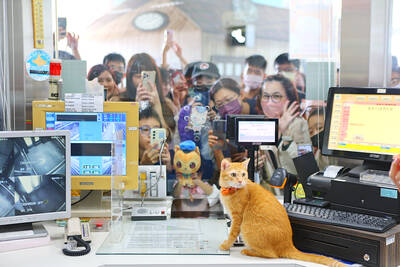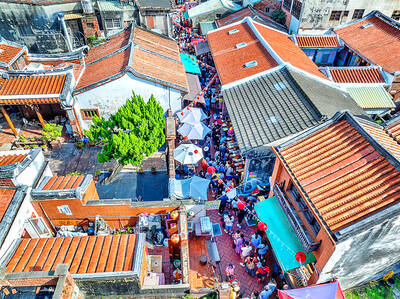The once pristine Siaoli River (霄裡溪), the source of drinking water for a small Hsinchu County town, has now become a battleground pitting local residents and environmentalists against two of the country’s most prominent manufacturers.
The dispute — a classic example of the tug-of-war between environmental protection and economic development — centers around the river’s growing pollution.
Sinpu Township (新埔) residents blame AU Optronics Corp (AUO) and Chunghwa Picture Tubes for the pollution, but the two high-tech companies deny any wrongdoing.
It may take months or even years to determine the source of the pollution, but residents are pleading for a quick solution to the degradation of their main water source, which was once one of the few rivers classified as having high water quality.
But in 2006, the Environmental Protection Bureau in Taoyuan County, where the Siaoli River originates, classified the stream as lightly polluted, and medium-polluted in certain seasons, although it did not find evidence of heavy metals.
ASSESSMENT
In an environmental impact assessment meeting last week, the two companies insisted that the wastewater they discharged into the river was not toxic, citing data showing that it conformed to environmental standards.
“But we believe that they hide some rare toxic elements that are not even part of environmental standards,” said Chen Jin-jin (陳金進), the head of an association of local residents that has followed the pollution issue for years.
At the meeting, the two companies proposed moving their discharge point from the Siaoli River to Taoyuan County’s Laochien River, which is already classified as “seriously polluted.”
The environmental panel, which held a meeting to decide on the proposal, failed to reach a decision and said the case would be reviewed in three months, leaving the issue unresolved for Sinpu residents.
Even if the wastewater is diverted elsewhere, however, it is hard to believe the Siaoli River will regain its past glory.
Adults recall when it was once a playground for the town’s children and served as a place to fish and wash clothes.
The river’s name may mean “river among the clouds, “but now it is simply a lonely river, without fish or children,” said Wu Jia-hsun, a retired school principal and Sinpu native.
“When I was little, I used to put a crab-pot in the ditch nearby. The next morning we could always find about one or two dozen crabs in it,” Wu said.
“But now, after the pollution, it’s difficult to find crabs,” he said.
Of greater concern to the town’s 36,000 residents, the river has also been an important source of drinking water because most households do not have access to tapwater.
Many are now forced to stock up on ground water from nearby mountains if they want natural drinking water.
Environmentalists believe the Chunghwa Picture Tubes and AUO factories built in 1999 near the head of the river are responsible for damaging the river.
Local residents say the plants, which each discharge about 20,000 tonnes of wastewater into the river a day, are impacting the health of people living alongside the river and damaging nearby rice fields.
“Thanks to the two factories, our Siaoli River has no more dry seasons,” said Chen, adding that the problem would not have arisen if original environmental guidelines had been followed.
APPROVAL
The Environmental Impact Assessment that gave conditional approval to the construction of the two factories stipulated that they would discharge their wastewater into a river more than 10km away, to prevent the Siaoli from being polluted.
“But the factories changed their drainage points to reduce costs,” Chen said.
Although the water emitted by the factories appears clear, fish disappeared from the Siaoli several years ago and the river now has an unpleasant chemical odor, he said.
At last week’s review meeting, representatives of the two companies reiterated that the tests on their wastewater discharge conformed to environmental standards.
But both were evasive, however, in describing the chemicals used during their manufacturing processes.
An owner of a downstream fish farm is convinced the companies are hiding something. He said about NT$30 million (US$987,000) worth of fish he was raising died overnight a few years ago, allegedly from pollution discharged by one of the plants, and he sued for damages in 2006.
The case is ongoing.
Humans may also be affected by the alleged pollution, as about 500 hectares of rice fields are irrigated with riverwater.
Chen said mercury has already been identified in at least one paddy in Sinpu, once known as “the granary of Hsinchu.”
There are also fears that the high electric conductivity in the water may lead to soil salinization.
The Taiwan Water Corp has tried to remedy the situation by pumping water from the Fongshan River, which feeds the Siaoli.
SKEPTICAL
But because the pumping station is located at the convergence of the two rivers — and is only separated from the Siaoli by a 1m high bank of soil and stones — residents remain skeptical about the quality of the water.
To fight for clean water rights, Chen and some college students have tried to convince the factories to move their drainage points, and plan to sue both the polluters and government agencies they suspect of malfeasance.
“We are only asking for clean, drinkable water and justice,” Chen said.

A cat named Mikan (蜜柑) has brought in revenue of more than NT$10 million (US$305,390) for the Kaohsiung MRT last year. Mikan, born on April 4, 2020, was a stray cat before being adopted by personnel of Kaohsiung MRT’s Ciaotou Sugar Refinery Station. Mikan was named after a Japanese term for mandarin orange due to his color and because he looks like an orange when curled up. He was named “station master” of Ciaotou Sugar Refinery Station in September 2020, and has since become famous. With Kaohsiung MRT’s branding, along with the release of a set of cultural and creative products, station master Mikan

RISING TOURISM: A survey showed that tourist visits increased by 35 percent last year, while newly created attractions contributed almost half of the growth Changhua County’s Lukang Old Street (鹿港老街) and its surrounding historical area clinched first place among Taiwan’s most successful tourist attractions last year, while no location in eastern Taiwan achieved a spot in the top 20 list, the Tourism Administration said. The listing was created by the Tourism Administration’s Forward-looking Tourism Policy Research office. Last year, the Lukang Old Street and its surrounding area had 17.3 million visitors, more than the 16 million visitors for the Wenhua Road Night Market (文化路夜市) in Chiayi City and 14.5 million visitors at Tainan’s Anping (安平) historical area, it said. The Taipei 101 skyscraper and its environs —

Taiwan on Friday said a New Zealand hamburger restaurant has apologized for a racist remark to a Taiwanese customer after reports that it had first apologized to China sparked outrage in Taiwan. An image posted on Threads by a Taiwanese who ate at Fergburger in Queenstown showed that their receipt dated Sunday last week included the words “Ching Chang,” a racial slur. The Chinese Consulate-General in Christchurch in a statement on Thursday said it had received and accepted an apology from the restaurant over the incident. The comment triggered an online furor among Taiwanese who saw it as an insult to the

ENROLLMENT STRATEGIES: NTNU focuses on English instruction to attract foreign students, and helps them with employment and internships, its president said The number of foreign students in the nation’s colleges and universities hit a five-year high last year, with National Taiwan Normal University (NTNU) topping the list with the most international students, Ministry of Education data showed. Last year, 123,188 international students attended Taiwanese colleges and universities, 3,259 more than the previous academic year, the data showed. NTNU had the most international students, with 7,648 students, followed by the National Taiwan University’s 6,249, it showed. NTNU yesterday said that international students accounted for 12.05 percent of its degree students last year. The percentage of overseas Chinese students at the university has also been the highest